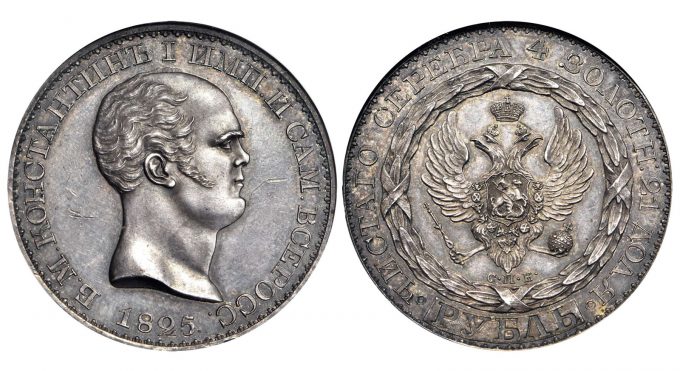Longstanding rare coin auction house Stack’s Bowers & Ponterio, whose experts have presented some of the most prestigious, highest-grossing sales in the industry’s history, is excited to feature the Pinnacle Collection as part of the firm’s semiannual Hong Kong auction.

This incredible collection features numerous rarities from the non-U.S. sphere of numismatics, many of which emanate from Japan. One such rarity, however, hails from a once-massive empire to Japan’s west — the mighty tsardom of Russia. Among Russia’s most famous coins, the fabled pattern ruble of Constantine possesses a background as fascinating as its rarity and value.
Issued for the would-be emperor, Constantine Pavlovich, the fabled pattern ruble is the only coin produced for this reign that never really happened. Constantine was the middle son of Emperor Paul I, and was seemingly destined for a life as the "spare" to his elder brother, the "heir."
Following Paul’s assassination, Alexander (the elder brother), Constantine, and Nicholas (the younger brother), were all weary of the crown’s burden. When Alexander died rather unexpectedly — and, more importantly, without a legitimate heir — the duty fell to Constantine.
Mint officials, mindful that coins reinforce the divine right of a ruler to the masses, immediately began producing a prototype so that official coinage could continue without interruption. Constantine, however, had other plans; he decided, after just a few weeks, that he wanted no part of his tsarist duty, abdicating the throne in favor of Nicholas.
In a flash, a would-be reign was brought to an end before it officially started. But what of the prototypes created by the mint officials? During this period of uncertainty, some eight examples were produced — five with edge lettering and three without. Rather than entering the melting pot, they were fortuitously preserved, with the five lettered edge specimens held for safe keeping within the Ministry of Finance and the three plain edge examples seemingly held by the officials present during their striking.
As the decades passed, the lettered edge rubles were obtained and dispersed by then-tsar Alexander II. Of the five, three are now held in museums (the Hermitage, the state Historical Museum in Moscow, and the Smithsonian). The remaining two have sold publicly and are presumably still in private collections. One last appeared in Bowers and Merena’s 1994 Baltimore auction, while the other has not officially been seen since 1898.
Turning to the plain edge examples, all three have had a presence in the marketplace, but only the specimen in question — this impressive piece from the Pinnacle Collection — has been seen since 1981. It last crossed the auction block in January 2004, and since then the rare coin market has enjoyed tremendous growth and prosperity, especially during the past year. When the gavel last fell for this monumental pattern issue, a record was established, making it the most valuable non-U.S. coin to sell at that time.
Nearly two decades later, the hammer price of $525,000 has been surpassed by other iconic ancient and world coins, a number of which are other Russian rarities. Given the current robust rare coin market and this pattern ruble’s status within the Russian series (perhaps being the most famous of them all!), a seven figure hammer is easily foreseen, especially when observing the $2 million-plus realizations brought by a Nicholas I pattern ¼ ruble or polupoltunnik (in 2013) and a Catherine II ‘the Great’ gold 20 rubles (in 2008), along with the nearly $4 million hammer of an Ivan IV pattern ruble (in 2012).
For the connoisseur of Russian numismatics, rare coins in general, or even exceptional works of art, the present pattern ruble is a prime candidate to perform incredibly well at the Stack’s Bowers & Ponterio Hong Kong auction in April.
For more information on the Stack’s Bowers & Ponterio April 2021 Hong Kong Auction or the Pinnacle Collection, visit the firm’s website at www.StacksBowers.com, call 800-458-4646, or email info@stacksbowers.com.
About Stack’s Bowers Galleries
Stack’s Bowers Galleries conducts live, Internet and specialized auctions of rare U.S. and world coins and currency and ancient coins, as well as direct sales through retail and wholesale channels. The company’s 85-year legacy includes the cataloging and sale of many of the most valuable United States coin and currency collections to ever cross an auction block — The D. Brent Pogue Collection, The John J. Ford, Jr. Collection, The Louis E. Eliasberg, Sr. Collection, The Harry W. Bass, Jr. Collection, The Joel R. Anderson Collection, The Norweb Collection, The Cardinal Collection and The Battle Born Collection — to name just a few.
World coin and currency collections include The Louis E. Eliasberg, Sr. Collection of World Gold Coins, The Kroisos Collection, The Alicia and Sidney Belzberg Collection, The Wa She Wong Collection, The Guia Collection, The Thos. H. Law Collection, and The Robert O. Ebert Collection.





